
An updated, urban version of the soil food web.
In the nearly sixteen years we’ve lived here we’ve seen our local stretch of Sunset Boulevard go from boarded up storefronts and auto body shops to restaurants, bars and cafes. Along with those new businesses and artisinal facial hair, comes a great new set of compost sources.
Some of my enterprising neighbors, one in particular, have been creating what could be called hipster compost or, at least, compost made from hipster sources. Interestingly these materials are often very high in nitrogen:
- brew waste from a local brewery
- coffee grounds
- fruit pulp from a juice bar
- coconut shells
My handy neighbor Ray has been shredding the coconut shells in his chipper to make a homebrew coir. Ray is also very consistent in picking up materials, something business owners appreciate.
Other than obvious sources such as yard waste and grass clippings, have you found a useful urban compost source? What did I leave out?
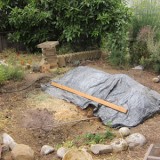
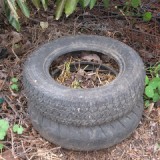
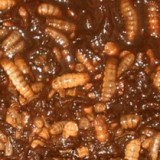

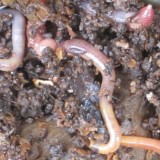
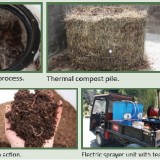
The LA Rabbit Rescue lady has lots of hay soaked in bunny urine with bunny poop pellets. She would love to give it to someone who is composting near Playa Vista. We have 2 bunnies and compost their litter (hay, urine, poop) with kitchen scraps and it composts very quickly. The compost must get hot to keep the oat, wheat and rye seeds in the hay from sprouting. No promises about being GMO free. Bunnies eat the hay, some pellets with soy and fresh produce. All non-organic.
Bunny droppings are great for the garden! Hopefully someone will take up the rescue lady on this generous offer.
Where do beard clippings figure into that diagram.
All hair, fur and nail clippings are fair game! This includes what collects in the drain basket in the shower or tub as well as self and pet grooming, IMO. I composted a morning dove that died after colliding with our window. Possums or rats may have retrieved it form the compost, but all I know is that it was gone in a few months.
Hair that has been processed/dyed would not be good. Right. That is a great visual.
For a long moment there I thought this post was going to be about picking a chipper rated for skinny jeans.
I guess my main concern here would be learning about the origin of the organic material sources. What’s the concentration level of pesticides or other chemical treatments in the fruit waste or coffee grounds? How fast does this break down in a compost heap? How much would we be hamstringing efforts at growing food organically by incorporating these other sources into our own compost heap?
I’ve never seen a good write-up on how safe the compost is when built up from non-organic sources. Do you guys have links to any studies?
zeke
Maybe Erik will have some links to actual science, but my vague understanding is that most of that stuff breaks down in the composting process. Also, many of these hipster sources are using organics ($12 organic green juices, etc.)
My dad worked as a research scientist for http://woodsend.org/ before he retired. This is just the kind of question that they would study. His primary client for many years was an herbicide maker that wanted to know if it could be broken down with the right mix in a compost pile and at what dilution it needed to be in order to not harm plants after having been composted. Herbicide is tough stuff. Dad didn’t find a way to get rid of it in compost and it must be very dilute not to cause problems. He didn’t study GMOs or other non-organic materials like chemical fertilizers or pesticides.
Hi,
Thanks for the link, Heather, and the response Mrs. Homegrown. I did a little googling myself after asking the question. Maybe some of the following will be helpful.
http://whatcom.wsu.edu/ag/compost/fundamentals/consideration_pesticides.htm
http://www.planetnatural.com/composter-connection/compost-concerns/pesticides/
http://compost.css.cornell.edu/faq.html#pesticide%20residues
zeke
Thanks, Zeke. Persistent herbicides are an absolute plague and abomination. I should have remembered to mention them.
Pesticides and chemical fertilizers do break down– but of course, it’s complicated and there are many variables. Generally I don’t let the perfect get in the way of the good (and nothing is better than compost) and so I am pretty relaxed about what I will compost, but Clopyralid can cause serious problems.
Boarded up storefronts? NO, those were all open establishments. They were Asian and Latino family owned stores that were priced out of their leases by the hipster gentrification invasion. Many of my favorite stores and bakeries closed down because of the premium a “wine bar” could pay with their white, trust fund clientele.
I thought this was going to be some new take on the whole ‘green dying’ movement, or lasagne gardening with indie record sleeves, plaid shirts and beard trimmings. I’m disappointed 😀
Our council leaves autumn leaves to rot on the pavement – huge volumes of free leaf mould material. Of course, you actually have to have autumns for that to be of use.
Horse manure isn’t very urban sounding, until you find out it is sourced from the wealthier horse keeping residents of the griffith park/glendale area. I have a garden plot at ocean view farms, a community garden on the westside, and they have a deal with the city and get tons and tons of horse manure/bedding. It is mostly pine shavings mixed with the manure, so the two compost on their own perfectly. They used to give free compost to the public on Mondays but not sure why they stopped recently. I had never had such amazing success with everything (peppers particularly) until I used this stuff in the soil.
I’ve had bad luck composting coffee grounds. They seem to attract Soldier Fly Larvae which putrefy the whole system and make the compost stick super bad, not to mention driving out the redworms.
I’d be interested to hear how it goes for her
We inquire with the produce people at our local organic grocers for boxes of what ever produce waste they may have. Sometimes what we get is divided in three, chickens, compost and some times the household kitchen-you can ew at that but what is the difference between an apple fallen and bruised in my yard and one that was bruised in a box? Not much in our book.
Anonymous, no “ew” about making use of bruised fruit in the kitchen from me! My mom used to say that it was a sin to waste food. How privileged have we gotten, to think that only cosmetically perfect produce belongs in our kitchens? We should be grossed out by the amount of food wasted in this country, not by efforts to reclaim it. Good for you.
Mrs PragSust collects a load of excellent compostable waste from her workplace. See http://pragmaticsustainability.blogspot.com.au/2013/04/composting-at-work.html for details.
And she always gets a seat on the train home for some reason!
Joshing. The compost transportation system is all nicely enclosed and odour-free 🙂
Pingback: 007 RIP Handsome, 3 Power Tools You Should Own and Hipster Compost | Root Simple